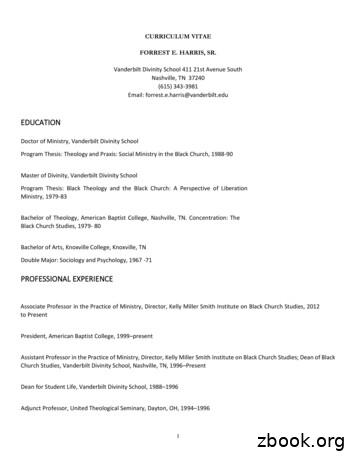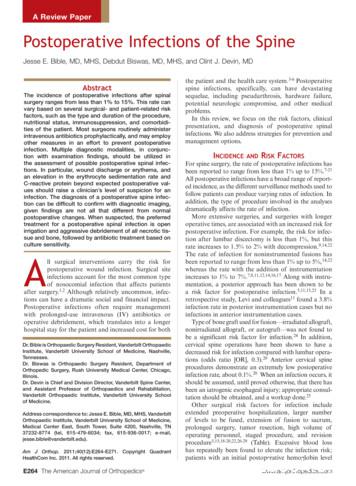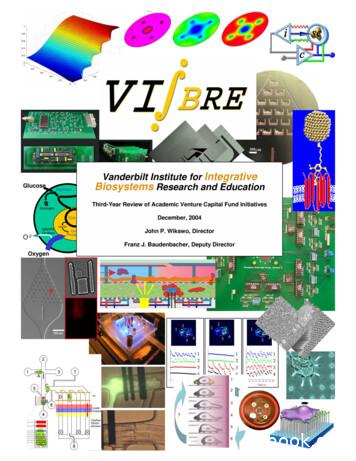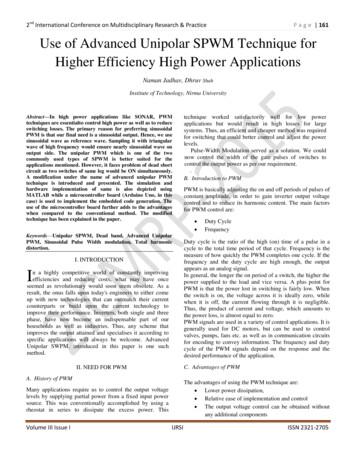BME PULSE - Vanderbilt University
BME PULSEVANDERBILT UNIVERSITYVOLUME 7-2 SPRING 20151
INSIDE THIS ISSUEP3SENIOR DESIGN DAYCONTRIBUTORSWRITERS:JACOB CHADWELLJENNIFER DUANP5AMY HWANGCLASS OF 2015SIMENG MIAOPAMELA WUEDITORS:P7DIONNE BLACKDR. GALLOWAYJENNIFER DUANASHLEY GNAMDESIGN:P8JENNIFER DUANCOURSE NUMBERSADVISORPROF. MICHAEL MIGAP12ViSE SYMPOSIUMCover image courtesy of Vanderbilt University Biomedical Engineering Department2
SENIOR DESIGN DAYDuring April, the School ofEngineering holds a senior designday which showcases the designprojects of every senior engineering major. Design day is the culmination of nearly a year of work forthe teams presenting. It is also anopportunity for various companiesand individuals to come and seethe multitude of projects. In addition, it is also the day that designawards are handed out to certainprojects and teams. This year,BME took home two out of threeAT&T Innovation awards.Overhead view of the Featheringhill atrium on Design Day.THE WINNING TEAMSSeniors Aditya Karhade, J.R. Peacock, Madeline Tolish and Fletcher Young took home the secondplace 1000 prize for their Hysteroscopic Surgery Simulator (HSS)project. The HSS provides a lower-cost alternative to current hysteroscopic training systems and willbe tested by Vanderbilt medicalresidents. The design features a3D printed uterus to create the environment and featured hapticfeedback and quantitative feedback about various skills associated with tasks a trainee is instructedto perform.The second place team with their Hysterostopic Surgery Simulator project.3
SENIOR DESIGN DAYThe winning team, 3DMD, wasanother four person team whosemembers are Nathaniel Braman,Attiyya Houston, Melena Mendiveand Simeng Miao. The winningteam took home 2,000. Their project utilized smartphone imagingand 3D printing to create castingsto correct clubfoot, which is a congenital deformity in infants. Withthe smartphone app, parents areable to take an active role in theirchild’s treatment by taking photosat several angles and using the appto predict the next cast the childneeds. Unlike most of the projectspresented, Team 3DMD’s projectwas conceived entirely by the students whereas other projects aregenerally chosen by a mentor.The first place 3DMD team.Example of a cast for clubfoot.3D Pprinted clubfoot cast model.3DMD’s clubfoot cast size.4
The Class of 2015AUTHOR: SIMENG MIAOEach May a new class of biomedical engineers graduates from the Vanderbilt University School of Engineering, ready to move on to the next phase of their lives. Undoubtedly, the Class of 2015 is a talented and diverse group: while they have all taken the same core classes, these students have found many different outletsin which to apply their biomedical engineering knowledge.“I picked biomedical engineeringbecause it gave me a broader perspective of engineering, and allowed me to understand howwhole systems work,” says MaryKate Hardy. As part of a biomedical engineering service class, shetraveled to Guatemala last year torepair medical equipment. KristinBarth also spent time studyingabroad as an undergraduate. “Iknow many engineers at otherschools can’t fit study abroad intheir schedule, so it’s nice thatVanderbilt offers it as an option,”says Barth. She spent a semesterin Dublin, Ireland, where she tooka variety of classes, including afood process engineering course.BME 290 Group in GuatemalaAs the year comes to a close, seniors reflect positively on their past four years at Vanderbilt. “I’ll miss beingsurrounded by people who like to work hard, but also like to have fun,” says Hardy. “I’m consistently beingchallenged in class and in the environment of learning that Vanderbilt builds,” adds Jevin Tzeng. After graduation, Tzeng will be working as an assistant in an oral surgery office before attending dental school. Otherseniors are planning careers in business school, graduate studies, and industry (Hardy recently accepted anoffer from Rice 360 Institute of Global Health Technologies; Barth will be working at Cerner Corporation, amajor company in healthcare delivery).Aditya Karhade, a biomedical engineering and neuroscience double major, will be attending Harvard Medical School in the fall. His advice for incoming students is to find mentorship opportunities and to form meaningful relationships. “When you come into college, you have interests, but you don’t necessarily have passions,” says Karhade. “As you form relationships with professors as mentors, you can learn from other people who have tested their interests to develop their passions.”5
One of the ways Vanderbilt helps develop engineering students’ passions is through Design Day, a capstoneproject where groups of students gain experience working on real-world projects. “Senior design allows us towork in a team without direct supervision from a professor, and we’ve had to work on pacing ourselves anddetermine the direction of our project,” says Barth. “This has been truly the first time that I have been able tomake prototype iterations of a device that could actually be marketed,” agrees Tzeng.“You get used to talking about problems with other people, and there’s asense of ‘taking care of your own’ among biomedical engineers.—Karhade”The seniors all agreed that what makes the biomedical engineering major unique is the collaboration and camaraderie between students. With difficult classes and weekly homework, students quickly learn that excelling in engineering requires communication and mutual support. “The problem sets are so tough that youhave to work together to solve them,” says Karhade. “You get used to talking about problems with other people, and there’s a sense of ‘taking care of your own’ among biomedical engineers.”The Class of 2015 will graduate on May 8th, 20156
Dr. Galloway’s GoodbyeAUTHORS: JENNIFER DUAN AND PAMELA WUThis year the BME department issaying goodbye to long-time faculty member Dr. Robert Galloway. Dr. Galloway has been atVanderbilt since January of 1985- the longest continuous time anyBME faculty member has been atVanderbilt. Dr. Galloway currently holds three titles: Professor ofBiomedical Engineering, Professor of Neurological Surgery andProfessor of Surgery. During histime at Vanderbilt, he has madeseveralcontributions including providing an instrumentationfocus to the BME department andstarting the popular BME electiveTherapeutic Bioengineering. Aswe say goodbye to Dr. Galloway,this article will explore his lifeand provide an idea of who he isoutside of a professor.Before Robert Galloway becamea professor at Vanderbilt University, he started his college careerat Duke University in Durham,North Carolina. He had aspired tobecome an oceanographer andhad been scuba diving since theage of 14. However, his plansquickly changed once he discovered the rigorous foreign languagespecifications a degree in marinebiology required. After lookingthrough a course catalog, he discovered Biomedical Engineering;which was right after marine biology. He decided he would givethis major a shot and ended upreally enjoying the field. He received his Bachelor’s degree inBME from Duke. Moving forward, he had the opportunity to goto medical school or to pursue aMasters in Engineering. Due tohis fascination with watching hisideas come to life, Dr. Gallowaychose to move on to the University of Virginia for his Master’s degree and finally returned to Dukefor his PhD, where his researchfocused on ultrasound imaging.After graduating from Duke, Dr.Galloway and his wife were bothable to find work at Vanderbilt.When he first came to Vanderbilt,Dr. Galloway was mentored byDr. Harris. Much like his time atDuke, Dr. Galloway’s initial research focus was on cardiac ultrasound. However, after MRI forlung imaging popped up as a hottopic, he discovered a new area ofinterest and was soon experimenting with MR images. From there,he began his work on image guided surgery, which is his currentresearch focus.Dr. Galloway’s retirement hasbrought many questions from students about what will happen tothe beloved Therapeutic Bioengineering elective. In fact, thecourse has had so much successthat it has been adopted by severalother universities. Although nodefinitive plans have been madeabout the fate of the course, Dr.Galloway says there are a few options for the course. One option isfor him to provide course notesfor whichever faculty memberwants to replace him as the Therapeutic Bioengineering instructor.Another option is for a team of7DR. GALLOWAYDr. Bob Galloway has been atVanderbilt for 30 years. Thisyear, he plans to retire to themountains of Virginia wherehe has designed his ownhome.engineers and physicians to collaborate and teach the course.While a final decision has notbeen made, Dr. Galloway saysthat if there is enough continuedinterest in the course, there shouldbe a way to continue providing it.When asked about his retirementplans, Dr. Galloway says he isbuilding a house in the mountainsof Virginia that is entirely his design. He plans to continue scubadiving and to work on water skiing. Although Dr. Galloway hasnot water skied in over 30 years,he plans on devoting time to relearn the sport. He will also beable to spend time with his dogsin the mountains of Virginia .
BME PULSE VOL 7.2THE BME MAJORAUTHOR: AMY HWANGWith new course numbering systems coming into effect for the fall of 2015, there have been questionsabout which courses are required for the biomedical engineering (BME) major. Although the courseshave been renumbered, the requirements remain largely the same as past years. The biomedical engineering major requirements at Vanderbilt are sectioned into a major core, liberal arts core, general degree requirements, major electives, and open electives. To graduate with a B.E. in BME, 127 credits and a minimum GPA of 2.0 are required. Both new and old class numbers will be used here, with the old coursenumber provided in parentheses. The number of credits each class provides is listed as well.MATHEMATICSMATH 1300 (155A). Single-Variable Calculus I [4]MATH 1301 (155B). Single-Variable Calculus II [4]MATH 2300 (175). Multivariable Calculus [3]MATH 2400 (196). Differential Equations with Linear Algebra [4]CHEMISTRYCHEM 102A. General Chemistry [3]CHEM 102B. General Chemistry [3]CHEM 104A. General Chemistry Lab [1]CHEM 104B. General Chemistry Lab [1]PHYSICSPHYS 1601 (116A). General Physics I [3]PHYS 1602 (116B). General Physics II [3]PHYS 1601L (118A). General Physics Lab I[1]PHYS 1602L (118B). General Physics Lab II [1]orPHYS 1901 (121A). Principles of Physics I [5]PHYS 1902 (121B). Principles of Physics II [5]8
BIOLOGYBSCI 1510 (110A). Intro to Biological Sciences [3]BSCI 1510L (111A). Intro to Biological Sciences Lab [1]COMPUTINGCS 1103 (103). Introductory Programming for Engineers and Scientists [3]CS 1101 (101). Programing and Problem Solving [3]ELECTRICAL ENGEECE 2112 (112). Circuits I [3]EECE 2213 (213). Circuits II [3]EECE 2213L (213L). Circuits II Lab [1]The general engineering requirements draw from a variety of disciplines, all of which eventuallyprove useful in BME courses. For example, MATLAB, taught in CS 1103, is used in BME 2100 andBME 2200 (at the professor’s discretion). Note that many of the BME engineering requirements arealso pre-med requirements, which makes BME the easiest engineering major to fulfill for pre-meds.MAJOR COREBME 2100 (101). Introductory Biomechanics [3]BME 2200 (103). Biomedical Materials: Structure, Property, and Applications [3]BME 3000 (210). Physiological Transport Phenomena [3]BME 3100 (251). Systems Physiology [3]BME 3101 (252). Systems Physiology [3]BME 4900W (255W). Biomedical Engineering Laboratory (Lecture and Lab) [3]BME 3200 (260). Analysis of Biomedical Data [3]BME 3300 (271). Biomedical Instrumentation (Lecture and Lab) [4]BME 4950 (272). Design of Biomedical Engineering Devices and Systems I [2]BME 4951 (273). Design of Biomedical Engineering Devices and Systems II [3]BME 4959 (297). Senior EngineeringDesign Seminar [1]9
Many of these courses are courses from other disciplines placed in a bioengineering context. For example, biomechanics is derived from mechanics (physics), biomedical materials is derived from materialsscience, and physiological transport is derived from heat and mass transfer and fluid mechanics(chemical engineering). Systems physiology uses MATLAB for modeling and simulations. For pre-medsit is recommended to push back BME 3000 to senior year, as it is a difficult class and usually taken injunior year, during which many students prepare for the MCAT.The major elective requirement is comprised of 12 credits of BME courses formerly numbered 203 orhigher. This is where you can explore your BME area of interest - topics ranging from bioelectricity tobiomedical imaging to nanobiotechnology are discussed. Note that many of these elective courses haveprerequisites that need to be taken into consideration. Up to 3 credits may be counted towards BME undergraduate research (BME 3860, 3861, 3850, 3851). However, if a deeper research experience is desired, an additional 3 credit hours may count toward the technical elective requirement described in thefollowing paragraph. Certain courses outside of BME may also count towards the elective core; studentswho are not double majoring in electrical engineering may take one of these courses: ChBE 4500(283), 4810 (282), 4870 (287), EECE 3214 (214), 4353 (253), 4354 (254), ENVE 4610 (272), or ME2220 (220).The technical elective requirement is comprised of 12 credits derived from several sources: 1) BME electives taken above the 12 credit minimum from the major elective requirement. 2) Most courses in theSchool of Engineering. 3) Most courses formerly numbered 200 or higher in the College of Arts and Sciences listed in the mathematics and natural sciences AXLE distribution category. Pre-meds can fulfill thetechnical elective requirement with courses such as biochemistry, organic chemistry, and statistics.The liberal arts core is required across all engineering majors. It is comprised of 18 credits, of which at 3hours each must be from 3 different Liberal Arts core categories. Additionally, 6 hours must be from onecategory. Pre-meds may fulfill most of these requirements with sociology, psychology, and English writing courses. AP credit may also be used to fulfill this core.And last but not least, there are 6 credits reserved for open electives. Any courses will fulfill this requirement, so students should use this to explore any other interests they may have.10
The objectives of the undergraduateBME program are to equip graduateswith the skillsets necessary to meet employer’s expectations and enable qualified graduates to pursue more advancedstudies. Therefore there is merit in mentioning the postgraduate outcomes ofprior BME classes. Graduation and jobstatistics provided by the School of Engineering are an enlightening referencefor future BME graduates.The BME Class of 2014 was comprisedof 59 graduates and was the second mostpopular engineering major behind mechanical engineering’s class of 77. Forgraduates accepting domestic employment offers, the average salary was around The BME Class of 2014 placement statistics 65,000 with a standard deviation of about 12,500. For BME graduates that expressed intention to go to medical or dental school, 90% were accepted.In comparison, the overall engineering Class of 2014 had a medical school acceptance rate of 82%. Toprepare for your future after graduation, Vanderbilt provides several valuable resources on campus suchas the Center for Student Professional Development, the Health Professionals Advisory Office, and professors themselves. Here one can find opportunities for internships, shadowing, research, and coachingthat prove invaluable.11
VISE SYMPOSIUMAUTHOR: JACOB CHADWELLBack in December, I had the opportunity to attend thethird annual Surgery and Engineering Symposium,put together by the Vanderbilt Initiative in Surgeryand Engineering (ViSE) Center. The symposiumopened with a coffee session sponsored by ZEISS(Carl Zeiss Meditec AG, Germany), the well-knownmanufacturer of surgical microscopes and novel imaging systems for medical use. Then, Dr. RobertSweet of the University of Minnesota presented thekeynote address, “The Emergence of Simulation Science for Healthcare.” Dr. Sweet’s presentation focused on the development of tissue and body simulations for surgical training. His vision is to allow surgeons to practice realistic surgeries where possiblecomplications may occur. The idea is that if a surgeoncan practice what happens when things go wrong, heor she will be extremely prepared to respond in acalm and effective way.ViSE Symposium PhotosA collection of photos from the December symposium.Images courtesy of Dr. MigaAfter the keynote speech, we moved back into thelobby for the poster session, where I was able to get aglimpse into the research and developments of thecampus ViSE labs. The ViSE program sits at the intersection of engineering and medicine, and it wastruly incredible to see the result of direct interactionsbetween engineers and doctors. From computationalmodeling for image-guided surgery, to surgical robotswith steerable needles, to advanced prosthesis, thevarious labs and their projects exemplified the resultsof collaboration among the biomedical, electrical,mechanical, and computer engineering disciplinesand the many clinicians who will be, in many cases,the end users of these technologies.Pictured above are:Dr. Mike Miga, PhD (Vanderbilt University Department ofBiomedical Engineering)The symposium was not only a great experience, butit also reminded me of what attracted me to Vanderbilt’s Biomedical Engineering program in the firstplace: the communication and collaboration betweenengineers and doctors that results in safer, more effective therapeutic techniques and technologies.Dr. Robert M. Sweet, MD (University of Minnesota, Department of Urology)Dr. S. Duke Herrelll, MD (Vanderbilt University MedicalCenter, Department of Urology)12
SUPPORT VU BMEThe Biomedical Engineering Program at Vanderbilt is continually striving to be the very best biomedi-cal engineering program in the country. Your support will help us achieve that objective. Please con-sider donating to theprogram—this will directly impact the resources for our undergraduates, the quality of the cutting-edge researchtaking place here in our laboratories, and ultimately the visibility of this very unique program.Todd D. Giorgio, Ph.D., Chair of Biomedical EngineeringA Contribution to the Biomedical Engineering Department at VanderbiltMy/Our gift commitment to the Biomedical Engineering Department is over the next years.Year 1 Please make checks payable to Vanderbilt University.I/we wish to put my/our first gift to work by placing it on mycredit card:VISA MastercardYear 2 Gift Amount:Year 3 Card Number:Year 4 Exp. Date:Year 5 To start my/our commitment, I/we have provided .Please send annual reminder notices in the month of.Name as it appears on Signature: Date:NAME:PREFERRED ADDRESS:PHONE: (h) (w)(fax)EMPLOYER: TITLE:VANDERBILT DEGREE(S) or AFFILIATION(S):EMAIL:Please Remove Back Page And Mail With Your Contribution To :Gift Processing, Vanderbilt University, PMB 407727,2301 Vanderbilt Place Nashville, TN 37240-7727ASK US ABOUT CORPORATE SPONSORSHIP (Email: Michael.I.Miga@vanderbilt.edu)13
at Duke University in Durham, North Carolina. He had aspired to . General Physics Lab I[1] PHYS 1602L (118B). General Physics Lab II [1] or PHYS 1901 (121A). Principles of Physics I [5] PHYS 1902 (121B). Principles of Physics II [5] . Introductory Programming for Engineers and Scientists [3] CS 1101 (101). Programing and Problem Solving [3 .
2009 Vanderbilt Football 2009 VANDERBILT FooTBALL VANDERBILT MISSISSIPPI STATE Location Nashville, Tenn. Starkville, Miss. Founded 1873 1878 Enrollment 6,402 17,824 Conference Southeastern Southeastern Nickname Commodores Bulldogs Colors Black & Gold Maroon & White Home Field Vanderbilt Stadium Davis Wade Stadium Capacity 39,773 55,082 Field Surface natural grass natural grass
Vanderbilt Divinity School 411 21st Avenue South Nashville, TN 37240 (615) 343-3981 Email: forrest.e.harris@vanderbilt.edu EDUCATION Doctor of Ministry, Vanderbilt Divinity School Program Thesis: Theology and Praxis: Social Ministry in the Black Church, 1988-90 Master of Divinity, Vanderbilt Divinity School .
Vanderbilt University, Department of Physics and Astronomy, Nashville, TN Associate Professor of Physics (1993-2000) Vanderbilt University, Department of Physics and Astronomy, Nashville, TN Assistant Professor of Physics (1986-1993) Vanderbilt University, Department of Physics and A
and involving the community in identifying gaps in service provision. Engaging with BME communities to better meet their healthcare needs is not simply a moral imperative or an exercise in political correctness. Intervening early and providing BME communities with the right health and social care could save the NHS money by reducing health
loans@vanderbilt.edu Financial Aid Overview. . Vanderbilt University Office of Student Financial Aid 615-322-3591 Anne.bathon@vanderbilt.edu. Title: Financial Aid 101 Author: SNG Created Date: 8/4/2020 2:47:53 PM .
Vanderbilt Orthopaedic Institute, Vanderbilt University School of Medicine. Address correspondence to: Jesse E. Bible, MD, MHS, Vanderbilt Orthopaedic Institute, Vanderbilt University School of Medicine, Medical Center East, South Tower, Suite 4200, Nashville, TN 37232-8774 (tel, 615-479-6034; fax, 615-936-0017; e-mail, .
EXECUTIVE SUMMARY The Vanderbilt Institute for Integrative Biosystems Research and Education, VIIBRE, was created in December, 2001 with a 5.1 million, five-year grant from the Vanderbilt . Venture Capital Fund (AVCF) to help move Vanderbilt University to a leadership role in basic research, technological development, and the delivery of .
Sinusoidal pulse width modulation (Carrier based Pulse Width Modulation Technique), Space vector pulse width modulation Single pulse modulation contains only one pulse per half cycle and the width of the pulse can be used to control the output voltage. In mul























